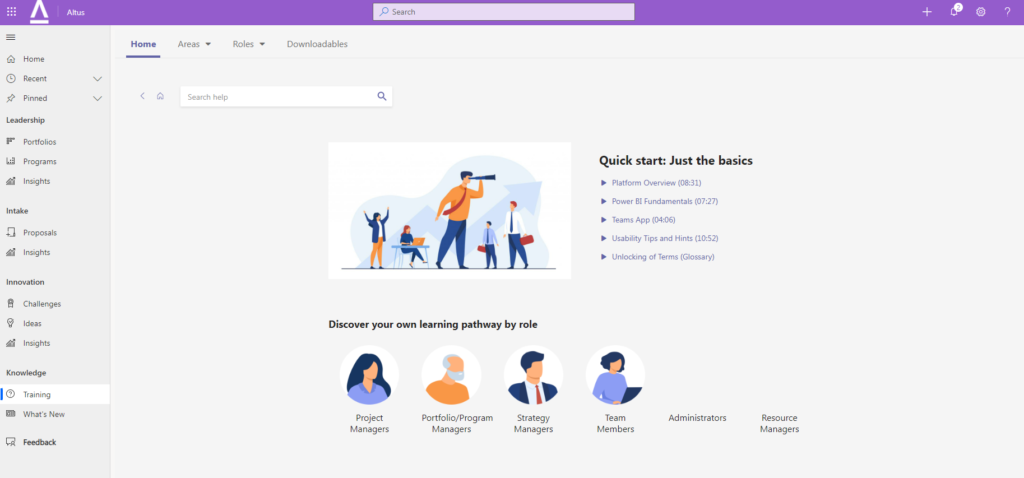Our recent webinar on Supporting all Project Management Maturity Levels covered some trending topics related to Project, Work and Task Management. Use this blog post as a reference for common questions regarding all things Project Management!
Be sure to also view the following link to the webinar recording: Access to webinar recording: Supporting all Project Management Maturity Levels – Sensei Project Solutions
Impacts of and managing different maturity levels
How to create a consistent but scalable framework to cater for a range of maturity levels across a single organisation?
Sensei ensures that your framework is easy to understand and provides users with the tools they want to use. The solution consolidates and automates all tools into one combined organisational wide view.
Below are 4 steps to ensure that users understand the importance of data maintenance.

Different PM maturity levels – what is the impact on implementing companywide resource management in URS?
Ensure that you have a Resource Management approach that links resources across your execution tools. Using a resource plan to request resources is the most appropriate way to confirm that your resources are managed across all levels of maturity. For example, we utilise Altus (PPM tool) which has a resource plan across all your schedule tools. It is easy to use and intuitive for users to request resources.

How do you recommend supporting the low maturity while not hindering the high maturity areas?
Sensei’s main priority is to provide users with the right scheduling tool. A low maturity project may want to use a tool like Microsoft Planner or Trello, whereas a professional Project Manager requires MS Project or Primavera. It is important to have the capability to consolidate and govern the project management process across all tools, which is what Altus does. It allows individuals to use the tool they want and provides the organisation with consolidation and automation.

What are some strategies to tailor your support to line of business PMOs within the same organisation at differing maturity level such as 1 & 3?
PMO needs to design a business process that satisfies needs while also being intuitive and easy to understand. Visualising and automating your business process will ensure a consistent approach that covers all maturity levels. The example below outlines how you can use Microsoft PowerApps to visualise your business process and automate it.

How to transition projects into using Project Management Tool when maturity is not fully developed.
Modern Project Management tools enable you to cover all levels of maturity allowing users (professional and citizen project managers) to intuitively manage projects. A modern tool should enable you to provide users with the tools they need and consolidate them into an organisational view.
Distinguishing characteristics of the different levels of Project Management Maturity and outline how organisations can ensure trustworthy project outcomes with all levels of project management maturity.
It is not an easy journey; however, it is possible when you focus on 3 main areas.
1. Try to make your process intuitive and automate as much as possible
2. Provide them with a digital tool that is appropriate to the maturity level (yes, one tool does not rule them all)
3. Listen to the needs of your people so they are satisfied when conducting their work.
What has worked well in educating non-project managers expected to lead projects?

A combination of the following:
- Training
- A support network (Hyper care)
- Provide a buddy that helps them manage projects
Here is an example of providing a computer training environment built into a Project Management solution. With today’s digitization, it is quite easy to provide this capability.

How do PMM levels align and be successfully managed in agile approached projects?
Agile is just another methodology on how to deliver a project. You still have your scrum masters and project managers to maintain and manage information required for the organisation. Try to find the commonality of the data you need to have and consolidate it. Here is a holistic view of how to ensure that you know what data you need.
Centralised versus decentralised project management, is there a model that works best or is it scenario based?
That is not a black and white answer and depends on the business. Generally, if the project volume allows then it is recommended to centralise it because we need to have an overall view of all projects.
How do you explain the benefits of project management maturity to officers?
The ability to have the skills to manage projects at all levels of complexity and being able to predict the outcome of a project.
What is the one biggest mistake people make?
The biggest mistake is not recognizing that all levels of a project management maturity exist in every organization.

Measuring project management maturity
What would be the key measures/observations to assess where we are as an organisation with our project maturity?
Some measures and indicators include:
- Do you have a list of all projects that are currently running?
- How much do you trust the information provided?
- Have the projects delivered the anticipated outcomes?
- Can you consolidate your projects into an overall picture for executive management to make decisions on?
What is the best approach to somehow get consistent reporting metrics across projects that may be all using different approaches/different methodologies?
Remember, methodologies anticipate ensuring that a project is managed consistent with consistent data (metrices). As a PMO you need to ensure that all Project Managers understand what data is managed and why.
What is the key to successfully improving PM maturity levels?
Identify WHY would you want to improve the maturity. Reasons may be a lack of success when delivering projects. Identify where the link is broken and rectify it.
How would you solve the issue of mapping a pathway for individual PMs to improve their level of maturity and recognise what level of maturity is required?
Firstly, the person should identify if they want to improve their individual PM maturity. Assuming so, there are many ways to gain knowledge which range from an internal “buddy” approach to online content and formal training. It is a personal development plan that would be appropriate in our opinion.
Tools/ technology to support varying PPM maturity levels
How can an enterprise solution support both the accidental unskilled PM and PM teams with expert scheduling skills and needs in a way that provides rolled up information from both for enterprise reporting and management?
Altus is built to cover all maturity levels. We do that by seamlessly integrating with project execution tools like Planner, MS Project, Jira, DevOps, and the ability to integrate with other execution tools. We recognise that not one tool will cover all maturity models. However, the governance of these projects is consistent in Altus.
How to best achieve project community buy in when releasing system and process enhancements?
Change Management is the magic word! Clear, continuous communication and listening to your end users to help them improve their work. Users will embrace it when you assist them reducing their day-to-day work.
How do you get projects to manage risks related to delivery as well as the operational risks that the project may be set up to mitigate, or operational risks that the project creates? These operational risks tend to be managed in an enterprise-wide risk management tool.
Project Risks are not organisational Risks. If possible, there should be a process of including these risks into the enterprise-wide organisational risk management tool. That means that Project Risks that are a potential organisational risk needs to be escalated.
How do we quickly train users when introducing new employees to project management systems? i.e., shorten the time to competency.
There are many ways, including:
- A buddy system where experienced PM’s upskill newbies
- A digital training environment as outlined in the previous answer
- An appropriate support network (e.g., PMO) acting as a security net
What project maturity measurement tool do you use?
Sensei does not use a tool. We recognise that all maturity levels need to be covered.
Can automation resolve some experience issues?
Yes. Automation can reduce administrative overhead and provide consistency, trustworthy outcomes.
The intuitiveness of Project for the web is ideal for PMs with minimal scheduling experience but are Microsoft considering lifting the 500-task constraint soon?
No we don’t believe that Microsoft will increase the task count. Microsoft suggests utilising MS Project if you have big and complex Projects.
PMO is trying to move to resource tracking in an organization that is not use to this type of tracking. How do we mature this discipline?
The general approach is to determine the accountability of resources. That is generally a team leads and not the PMO. An option is to determine a resource management process that enables PMs to request, and team leads to approve.
Should Project Risk be entered into the Project Schedule?
Generally not. However, if you have important tasks to manage a risk, that may be a reason to schedule it. Especially if it impacts the timeline.
Altus questions
How can we best use Altus to support the executive team in relation to the health of its portfolio of investments?
Provide the team with the right insight to make objective decisions.
Can Altus be used as a simple task list, or would you divert that need to MS Planner?
Altus integrates with Planner seamlessly
How do we use Altus to manage possible different levels of maturity in Project Management?
You can use Altus right now to cover all levels of Project Management Maturity. We integrate with all common schedule tools and provide the governance across all projects with the ability to consolidate projects, programs, and portfolio on an organisational level.
Why Altus?
Because you want to improve the way you work 😉. Please visit our website: www.sensei.cloud or contact us.



